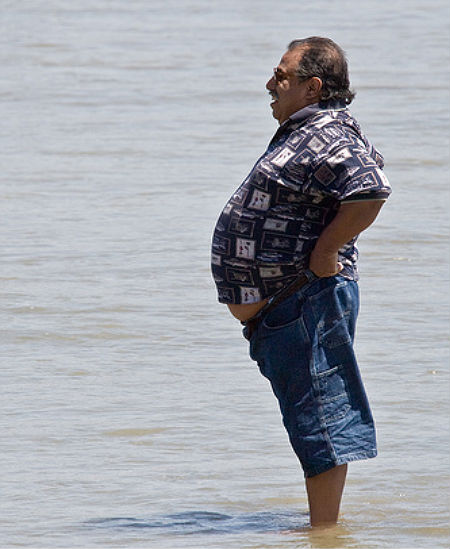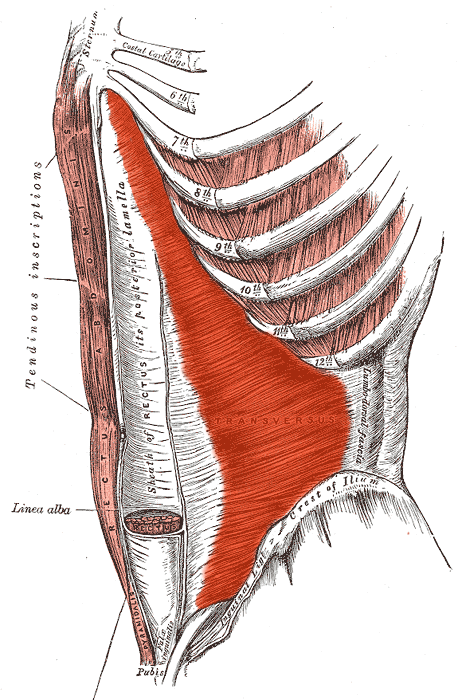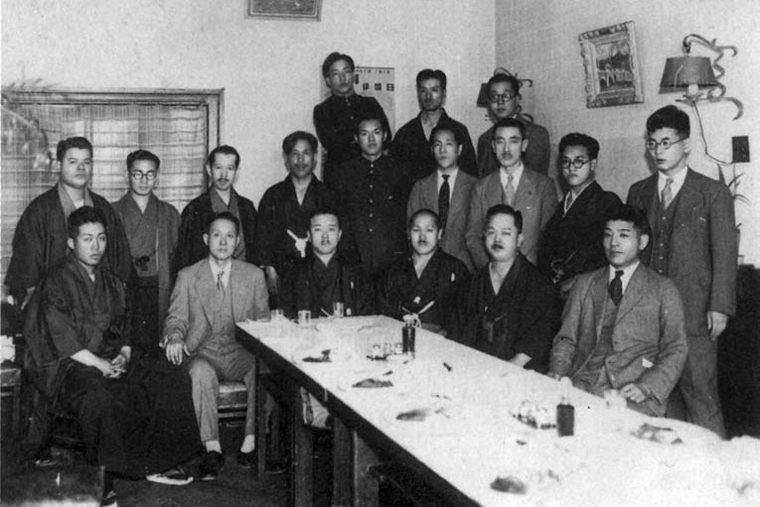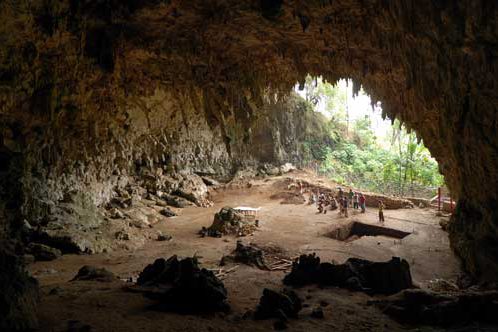This is part 2 of ‘Naha-te’s 2 Greatest “Secret” Lessons’. If you haven’t read part one, go ahead. I’ll wait. Not really, but I’ll pretend to.
You know how we sometimes use expressions containing body parts when we want to say stuff?
I mean, like: “cost an arm and a leg”, or to “put your back into it” or “armed to the teeth” or “put your best foot forward”. Know what I mean? Well, the Japanese have a lot of those. And idioms like these are quite interesting, because they tell you a lot about a culture.
For instance, quite a few Japanese body part idioms are about the hip (“koshi”) and the abdomen (“hara”). There are not that many of those in English, that I know of at least (except about guts, yuck!).
Here are some examples of Japanese expressions containing hip:
- “Heppiri koshi” (to be afraid) – lit. to have your hip pulled back and stuck out
- “Kenka koshi” (being aggressive) – lit. noisy hip
- “Koshi kake shigoto” (a temporary job) – lit. a hip hanging job
- “Yowa koshi gaikou” (weak-kneed diplomacy) – lit. frail hip diplomacy
See? Hip is “hip” in Japan. There are many more expressions containing the hip too. And, as you hopefully remember, that was what the first lesson of Naha-te was all about – the pelvis (hip, “koshi”) tilt, right?
Something all Karate styles (and martial artist in general) should implement.
However, let’s forget the hip for a moment and turn our “hips” towards the (okay, that was not even fun) lower abdomen, or “hara”, for just a sec.
(By the way, did you know I love “hip”-hop?)
Here are some examples of Japanese expressions containing abdomen:
- “Hara gurui” (to be wicked) – lit. black abdomen
- “Hara wo tateru” (to lose one’s temper) – lit. rising the belly
- “Hara ga suwaru” (to be unwavering in one’s resolution) – lit. the hip is sitting
- “Hara kiri” (ritual suicide) – lit. abdomen cut
Just like with the hip, there are maybe hundreds of other Japanese expressions containing “hara” or abdomen. That should say something about how important this is to people in general (at least Japanes people), and to Karate people in particular.
And that’s what today’s Naha-te lesson #2 is all about: The hara (which, in martial arts terms, refers to the lower abdomen) and it’s most important underlying muscle, known in latin as the transversus abdominis muscle. If you ask me, knowing how (and WHY) the transversus abdominis plays a significant role in Karate should be considered mandatory study for any (half)serious Karate enthusiast.
Because, as Keiji Tomiyama (7th dan Shito-ryu Kofukan) says:
This is where your centre of gravity should be. Without a stable centre of gravity you cannot keep good balance and perform techniques with weight behind them. To be able to keep one’s centre of gravity at the HARA, one has to learn abdominal breathing, which involves up and down movement of the diaphragm.
(More about that last part in ‘The Double-Edged Sword – Sanchin’).
So, let’s begin, shall we?
Naha-te Lesson #2: Transversus abdominis.
Imagine that you’re walking down the beach.
It’s a hot day in June, in a tropical place somewhere (Okinawa?), and hundreds of hot blond babes/dudes are watching you (okay, NOT Okinawa!) as you gracefully dip your toe in the water.
Your stomach?
It’s definitely not hanging out!
And I don’t care how you look like when you’re taking a shower at home, but right now you’re sucking that puppy in as hard as you can, because hundreds of hot dudes and dudettes are not going to see you all bulky and stuff!
In fact, you’re looking very much like an older David Hasselhoff:

And who’s to blame you?
Well… you guessed it.
I am.
In fact, when speaking about things like “hara”, transversus abdominis, core, Karate power, abs and such, I would be happier if you did this:

There’s a man who knows his hara.
(not his pelvic tilt though!)
Now, I know you’re not supposed to hassel the hoff, but these days waaaay too much emphasis is placed on training and hardening the external abdominal muscles (the ones you can actually see) instead of the internal abdominal muscles (which you can’t see), of which the transversus abdominis is the deepest.
The deepest, least visual yet most important of the abdominal muscles.
Ask any opera singer.
I mean, do you want to actually be functional or look functional? Be, of course. Consider the transversus abdominis then. Because, contrary to common belief, your everyday abs do not contract to a significant degree when doing maximal explosive lifting, pulling and pushing movements (Karate consists of all of these plus much more).
Several studies of the electrical activity of the stomach shows that it is in fact the deeper internal muscles (read: transversus abdominis) which are much more involved and active in sporting performance (I admit, not that many studies have been made on Karate per se, so we’ll just have to assume the same holds true here, mmkay?).
Now, let me ask you something:
Have you seen somebody of a higher level in Karate (who actually knows his stuff) perform a kata without a gi? So that you can actually see the different functional muscles work?
If yes, did he/she look… ehrm… how should I put this…
Fat?
Okay, not really fat, but… awesome? (I really need to expand my vocabulary). And don’t tell me the above man doesn’t know his stuff, because that’s Terauchi Kazuo sensei (8th dan Okinawa Goju-ryu), he has been training longer than I’ve been breathing. He’s not even that old by the way.
But, his performance looks nothing like Hasselhoff on the beach. Obviously he must be tensing his stomach like crazy, but we don’t see it in the way we’re used to seeing it (think photomodels, MMA stars etc..). Because, he goes for function over form.
If you want to utilize the most effective breathing pattern for greatest power production (which is ~75 % of air left in lungs in speed-strength sports according to Vorobyev, 1978) you’d best be using your transversus abdominis, since it is the primary muscle controlling breathing force during exhalation/inhalation (in abdominal breathing, not the higher lung/chest type breathing which we can leave to the less knowledgeable).
Now, I am threading a very thin line here, because I’m again not an expert on anything and I don’t want this to become a debate on breathing (and the much debated Valsalva maneuver, which rocks by the way), so I will just conclude by giving you a nice way of practising how to actually find your transversus abdominis, since you can’t really see it, only it’s effect on your external abdominal muscles (= fat, non-babe-magnet-beach-stroll-mood looking)
Put your hands on your hips, and press in.
Now slide them upwards, slowly, until you have slid over you hip bone and landed around the love handle area. Your hands will sink in here. Found it?
Good.
Now keep pressing in, and simply cough.
Cough again.
If you’re skilled, sneeze too.
Feel something? Your hands are pushed outwards by some mystic force, right?
Well, the transversus abdominis plays a hand in this mystic force. Continue by tying a Karate belt around your waist extra hard, and then practise tensing the same muscles we just used in the cough – but without coughing. Do it by just locating the correct muscles by yourself, relying on what may be called your sixth sense, called proprioception by physiologists.
Do it slowly, do it fast. While breathing out slowly, while breathing out fast (you’re inner core muscles are activated by breathing, not by situps!). Once you’ve mastered your transversus abdominis, you will not only frown upon people sucking their stomach in, but you’ll be able to excert far more power in your techniques than previously possible (provided you use it right), by consciously – later unconsciously – activating your correct muscles; giving you a stronger and more functionally stable core.
Whoah, that was a long sentence.
Got it?
Great.
“Ashi de keruna, koshi de kere; Te de tsukuna, hara de tsuke.”
“Don’t kick with your leg, kick with your koshi. Don’t punch with your hand, punch with your hara.”
Naha-te’s second “secret” Karate lesson is officially over.
Step yo’ game up!



18 Comments